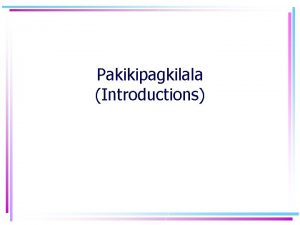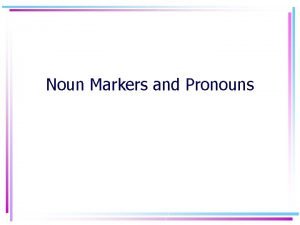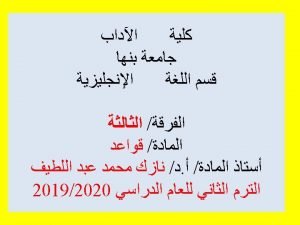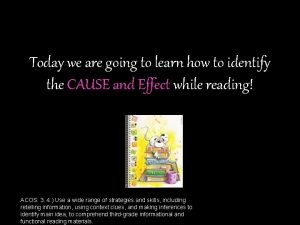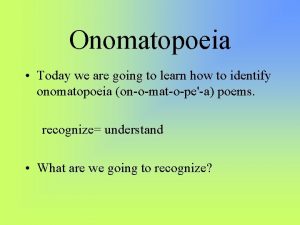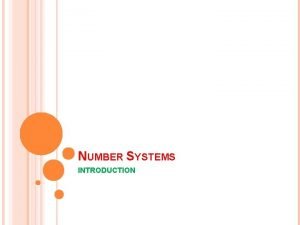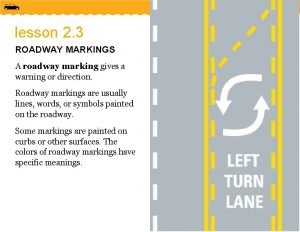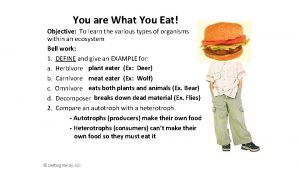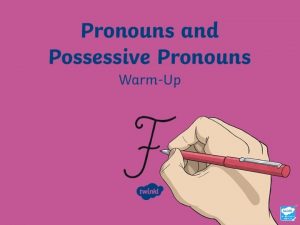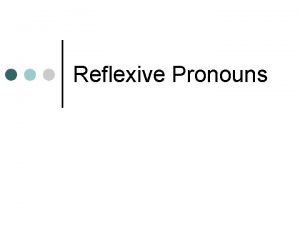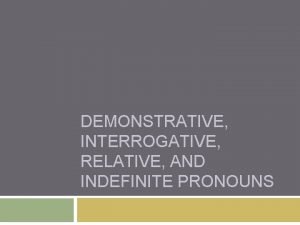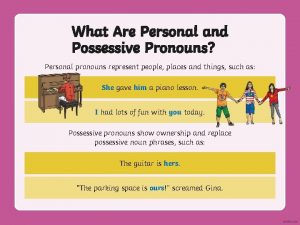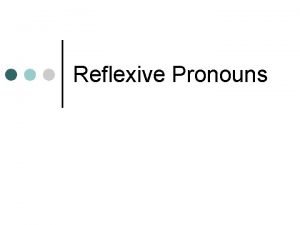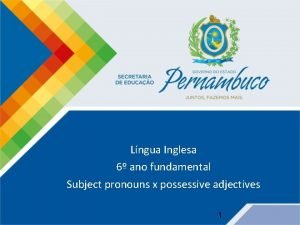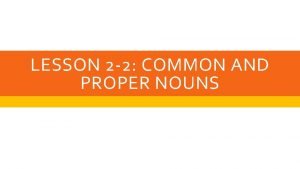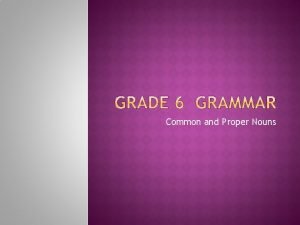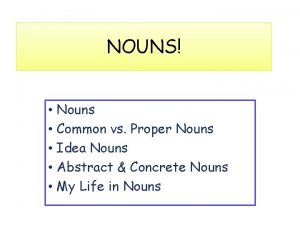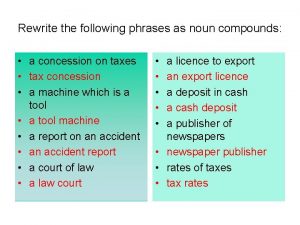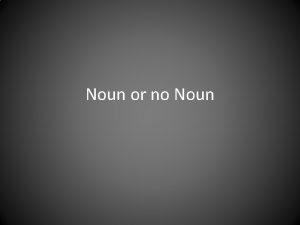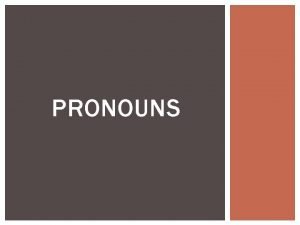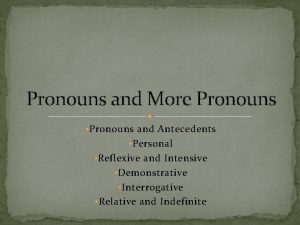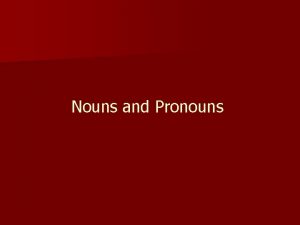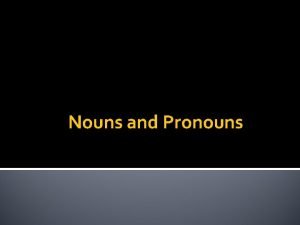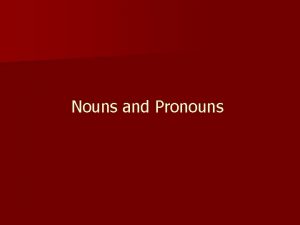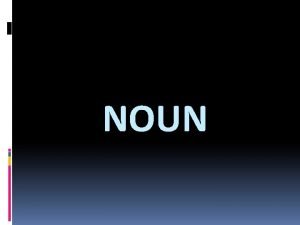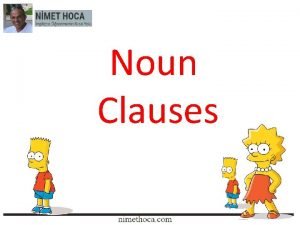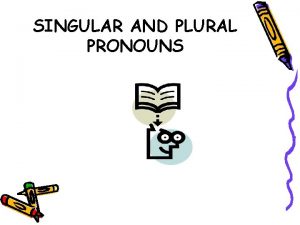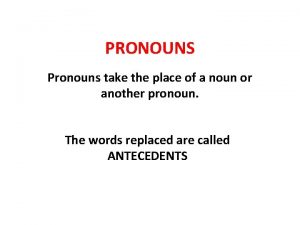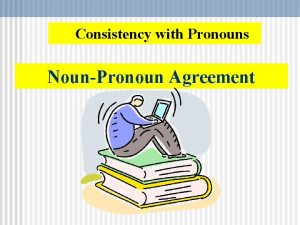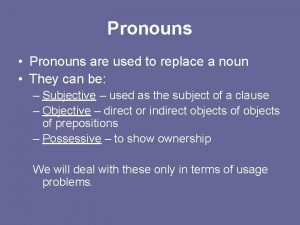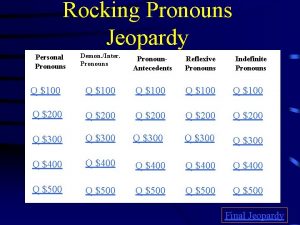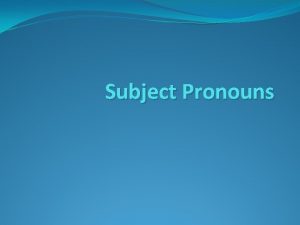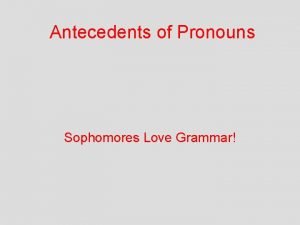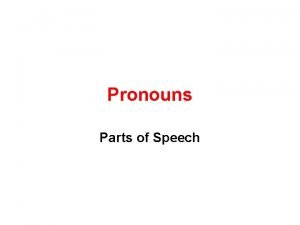Noun Markers and Pronouns Today you will learn





































- Slides: 37

Noun Markers and Pronouns

Today, you will learn about: • Noun markers (they tell you about the “focus” or subject of the sentence) • Pronouns

SUBJECTS You know you have a subject when you see “ANG” or “ANG MGA” or “SINA”

Noun markers for subject: ANG • Singular: ang Tumawa ang bata. (The child laughed). • Plural: ang mga Tumawa ang mga bata. (The children laughed. ) • Ang and ang mga can also be used for things: Tumahol ang aso. (The dog barked)

ang bata ang mga bata

Personal noun markers (goes with names of people) • Singular: Tumawa si Joel. (Joel laughed) • Plural: Tumawa sina Joel at Agnes (Joel and Agnes laughed).

si Joel sina Joel at Agnes

Pronouns in focus form (denote subject of the sentence) • Personal pronouns (1 st, 2 nd, 3 rd person) singular -1. Ako (I): Ako ay tao. (I am human) -2. ka, ikaw (you—informal): Ikaw ang kaibigan ko. (You are my friend). Kayo (you—formal): Kayo po ang guro ko. (You are my teacher) -3. Siya (he or she): Siya ang kaibigan ko.

ako ikaw kayo siya (formal)

Pronouns in focus form (denote subject of the sentence) • Personal pronouns (1 st, 2 nd, 3 rd person) plural • Kami (we, exclusive): Taga-Acton kami (We are from Acton—excludes others). • Tayo (we, inclusive): Taga-IP tayo (We are (all) from IP). • 2. Kayo (you): Mga bata kayo. (You are young). • 3. Sila (they): Mga lalake sila (They are guys).

kayo kami tayo sila

Demonstrative pronouns (this, these, that, those): Singular • Ito (this—near the speaker) Ito ang libro ko. (This is my book) • Iyan (that—near the listener) Iyan ang libro mo. (That is your book) • Iyon (that—far from both speaker and listener) Iyon ang kotse ko.

ito iyan iyon

Demonstrative pronouns (this, these, that, those): Plural • Ang mga ito (these—near the speaker) Libro ko ang mga ito. (These are my books. ) • Ang mga iyan (those—near the listener) Libro mo ang mga iyan. (Those are your books. ) • Ang mga iyon (those—far from both speaker and listener) Kaibigan ko ang mga iyon.

Ang mga ito Ang mga iyan Ang mga iyon

NON-FOCUS FORMS (not the subject of the sentence)

NG—indicates possessive form

Ng (possessive)—indicates belonging to • Singular: ng Ito ang libro ng bata. (This is the book of the child). • Plural: ng mga Ito ang libro ng mga bata (This is the book of the children) • Singular (personal): ni Ito ang aso ni CC. (This is CC’s dog) • Plural (personal): nina Ito ang pagong nina CC at Lucas. (This is CC and Lucas’s turtle).

bola ng bata (This is Maria) bola ni Maria bola ng mga bata Maria Elen bola nina Maria at Elen

Possessive personal pronouns: singular • 1 st person singular: Ito ang libro ko. (This is my book) • 2 nd person singular, informal: Ito ang libro mo. (This is your book). • 2 nd person singular, formal: Ito po ang libro ninyo. (This is your book). • 3 rd person singular: Ito ang libro niya. (This is his/her book).

Ito ang pagkain ko Ito ang pagkain mo Yum yum Ito ang pagkain ninyo Yum yum Ito ang pagkain niya (formal) Yum yum Pero gutom ako!

Possessive personal pronouns: plural • 1 st person plural, exclusive: Ito ang bahay namin. (This is our house) • 1 st person plural, inclusive: Ito ang bahay natin. (This is our house). • 2 nd person plural: Ito ang bahay ninyo. (This is your house). • 3 rd person plural: Ito ang bahay nila. (This is their house).

Ito ang pagkain namin Yum yum Ito ang pagkain natin Yum yum But I’m hungry! Ito ang pagkain ninyo Yum yum Ito ang pagkain nila But I’m still hungry! Yum yum

Demonstrative pronouns, possessive • Singular, near the speaker: Pula ang kulay nito. (Red is the color (of the object) or, That is red) • Singular, near the listener: Bughaw ang kulay niyan. (Blue is the color (of the object). • Singular, away from listener and speaker: Berde ang kulay noon. (Green is the color (of that distant object)).

Dilaw ang kulay nito Dilaw ang kulay niyan Dilaw ang kulay noon

Demonstrative pronouns, possessive • Plural, near the speaker: Pula ang kulay ng mga ito. (Red is the color (of these objects) or, These is red) • Plural, near the listener: Bughaw ang kulay ng mga iyan. (Blue is the color (of those objects). • Plural, away from listener and speaker: Berde ang kulay ng mga iyon. (Green is the color (of those distant objects)).

Dilaw ang kulay ng mga nito Dilaw ang kulay ng mga iyan Dilaw ang kulay ng mga iyon

SA All sorts of prepositions: to, towards, in, on, at, from, belonging to

Sa • Singular: Pupunta ako sa palengke. (I am going to the market) • Plural: Pupunta ako sa mga tindahan. (I am going to the stores) • Personal, singular: Sasabay ako kay CC. (I am going with CC). • Personal, plural: Sasabay ako kina CC at Lucas (I am going with CC and Lucas).

• 1 st, singular: Sasabay ka sa akin. (You’re coming with me). • 2 nd, singular: Sasabay ako sa iyo. (informal) (I’m going with you). • 2 nd, singular: Sasabay po ako sa inyo. (formal) (I’m going with you). • 3 rd, singular: Sasabay ako sa kanya. (I’m going with him).

• 1 st, plural, exclusive: Sasama siya sa amin. (He’s coming with us—but not with you). • 1 st, plural, inclusive: Sasama siya sa atin. (He’s coming with us—all of us). • 2 nd, plural: Sasabay siya sa inyo. (He’s going with you). (y’all) • 3 rd, plural: Sasabay siya sa kanila. (He’s going with them).

Sabay ka sa akin! Sabay ako sa iyo! Hmm, saan siya pupunta? Makisali nga… Sabay ako sa kanya! Ayaw. Sama ka sa amin? Sasama siya sa atin? hindi Sabay rin ako sa kanila!

Demonstrative pronouns, singular • Near the speaker: Umupo ka rito. (Sit here). • Near the listener: Tumayo ka riyan (Stand there). • Far away from both: Pumunta ka roon. (Go there).

Prrrt! Huli ka! Punta ka rito! Ano ang ginagawa mo riyan? Hala, punta tayo roon sa presinto! Ay, patay!

When to use dito/rito, diyan/riyan, doon/roon • Malalim dito. (It’s deep here)/ Nahulog siya rito. (He fell down here) • Matarik diyan. (It’s steep there)/Mabaho riyan. (It stinks there). • Mapanganib doon. (It’s dangerous there). /Maganda roon. (It’s beautiful there).

Demonstrative pronouns, plural • Bilib ako sa mga ito. (I am impressed by them). • Nawili ako sa mga iyan. (I was tempted/enchanted by those—near the listener). • Nasabik ako sa mga iyon (I was interested/excited by those—far away from both).

Sa (ang) mga ito Sa (ang) mga iyan Sa (ang) mga iyon
 Expressions of quantity
Expressions of quantity Today you will learn
Today you will learn Collective noun of cereal
Collective noun of cereal Raw at daw pagkakaiba
Raw at daw pagkakaiba Incomplete noun clauses
Incomplete noun clauses You live to learn
You live to learn Kinetic learning
Kinetic learning How you use ict today and how you will use it tomorrow
How you use ict today and how you will use it tomorrow What are we going to learn
What are we going to learn Learn today lead tomorrow
Learn today lead tomorrow Today we are going to learn
Today we are going to learn Today we are going to learn about
Today we are going to learn about Onomatopoeia
Onomatopoeia What will we learn today
What will we learn today What do red raised roadway markers mean
What do red raised roadway markers mean The more you study the more you learn
The more you study the more you learn Getting nerdy llc
Getting nerdy llc Today meeting or today's meeting
Today meeting or today's meeting In todays lesson
In todays lesson Today meeting or today's meeting
Today meeting or today's meeting Fingerprint ridge characteristics worksheet
Fingerprint ridge characteristics worksheet Today's lesson or today lesson
Today's lesson or today lesson Today's lesson or today lesson
Today's lesson or today lesson Possessive and personal pronouns
Possessive and personal pronouns Relative pronoun as possessive
Relative pronoun as possessive Function of
Function of Demonstrative interrogative and relative pronouns
Demonstrative interrogative and relative pronouns Circle the demonstrative adjectives
Circle the demonstrative adjectives Personal and possesive pronouns
Personal and possesive pronouns Reflexive or reciprocal pronoun
Reflexive or reciprocal pronoun Reflexive pronouns
Reflexive pronouns Subject pronouns exercícios
Subject pronouns exercícios Adjective dependent clause
Adjective dependent clause Proper noun images
Proper noun images Identify common and proper nouns in paragraph
Identify common and proper nouns in paragraph Common noun and proper noun project
Common noun and proper noun project Proper idea nouns
Proper idea nouns Noun compounds and noun phrases
Noun compounds and noun phrases

